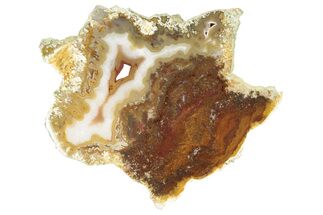This Specimen has been sold.
8" Polished Trent Agate With Stibnite & Realgar - Oregon
This is a phenomenal and rare specimen of Trent agate that is 8" wide and has been polished to a mirror-like finish. It comes with an acrylic display stand.
The white bordered photo is a backlit photo of the specimen, explaining the color change between the black and white bordered photos. The depth of the stibnite crystal formations can clearly be seen in this backlit photo.
The white bordered photo is a backlit photo of the specimen, explaining the color change between the black and white bordered photos. The depth of the stibnite crystal formations can clearly be seen in this backlit photo.
Trent stibnite agate, also known as "Trent agate", is a very unique and rare agate formation that occurred around crystal sprays of stibnite and/or realgar. Trent agate was collected in the 1960s from a railroad cut in Trent, Oregon. Following an accident at the site of collection, the mine was closed and eventually covered by a road. Specimens of this beautiful agate are now only obtainable through old collections.
Like many other agates, Trent agates form when microscopic silica crystals deposit into cavities in concentric layers within cavities of rocks. Its colors depend on impurities within the silica-rich depositing solutions: in this case Trent agate is colored by arsenic, realgar, and stibnite impurities.
While both realgar and stibnite are toxic and can be harmful if inhaled or swallowed, they are encased in silica in this specimen and would not pose a health hazard. We still encourage washing your hands after handling this material to be on the safe side.
Like many other agates, Trent agates form when microscopic silica crystals deposit into cavities in concentric layers within cavities of rocks. Its colors depend on impurities within the silica-rich depositing solutions: in this case Trent agate is colored by arsenic, realgar, and stibnite impurities.
While both realgar and stibnite are toxic and can be harmful if inhaled or swallowed, they are encased in silica in this specimen and would not pose a health hazard. We still encourage washing your hands after handling this material to be on the safe side.
About Stibnite
Stibnite is a striking mineral composed of antimony sulfide and is best known for its metallic luster and dramatic, elongated crystal formations. It often forms slender, prismatic crystals that can cluster into stunning radiating or parallel groups. Its color ranges from silvery-gray to steel-blue, with a reflective sheen that enhances its visual appeal. Stibnite is relatively soft, with a Mohs hardness of 2, making it easy to scratch but still prized for its aesthetic qualities.
This mineral has been historically significant as a primary source of antimony, a metal used in alloys, flame retardants, and batteries. Stibnite specimens are highly sought after by collectors due to their unique appearance and rarity. Major localities include China, Japan, and the United States, with some of the finest examples originating from the Wuning Mine in Jiangxi Province, China. Despite its beauty, stibnite contains toxic antimony and should be handled with care.
Toxicity Warning: Stibnite (antimony) is toxic and can be harmful if inhaled or swallowed. Most of the risk is long-term, chronic exposure to its dust. While a crystal sitting on your shelf doesn't pose a health risk, you should wash your hands after handling, keep out of reach of children, and please don't lick the stibnites.
Stibnite is a striking mineral composed of antimony sulfide and is best known for its metallic luster and dramatic, elongated crystal formations. It often forms slender, prismatic crystals that can cluster into stunning radiating or parallel groups. Its color ranges from silvery-gray to steel-blue, with a reflective sheen that enhances its visual appeal. Stibnite is relatively soft, with a Mohs hardness of 2, making it easy to scratch but still prized for its aesthetic qualities.
This mineral has been historically significant as a primary source of antimony, a metal used in alloys, flame retardants, and batteries. Stibnite specimens are highly sought after by collectors due to their unique appearance and rarity. Major localities include China, Japan, and the United States, with some of the finest examples originating from the Wuning Mine in Jiangxi Province, China. Despite its beauty, stibnite contains toxic antimony and should be handled with care.
Toxicity Warning: Stibnite (antimony) is toxic and can be harmful if inhaled or swallowed. Most of the risk is long-term, chronic exposure to its dust. While a crystal sitting on your shelf doesn't pose a health risk, you should wash your hands after handling, keep out of reach of children, and please don't lick the stibnites.
About Agate
Agate is a variety of microcrystalline quartz (chalcedony) that displays translucence and, in some cases, banding. Agate primarily forms when silica-rich fluids fill pockets within rocks and/or fossils, depositing the silica along the walls of the rock. This process can result in banding patterns, as the compositions and impurities of these depositing fluids change over time. These banding patterns can either form as flat layers, creating linear patterns known as waterline agate, or as rounded layers, forming more common ring-like patterns. These patterns depend on the surfaces available for deposition.
Agate is a variety of microcrystalline quartz (chalcedony) that displays translucence and, in some cases, banding. Agate primarily forms when silica-rich fluids fill pockets within rocks and/or fossils, depositing the silica along the walls of the rock. This process can result in banding patterns, as the compositions and impurities of these depositing fluids change over time. These banding patterns can either form as flat layers, creating linear patterns known as waterline agate, or as rounded layers, forming more common ring-like patterns. These patterns depend on the surfaces available for deposition.
SPECIES
Stibnite, Realgar & Chalcedony var. Agate
LOCATION
Trent, Oregon
SIZE
8 x 3.6", .13" thick
CATEGORY
SUB CATEGORY
ITEM
#141191
 Reviews
Reviews














